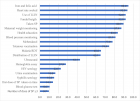Abstract
Research Article
in silico discovery of potential inhibitors against Dipeptidyl Peptidase-4: A major biological target of Type-2 diabetes mellitus
Nouman Rasool*, Andleeb Subhani, Waqar Hussain and Nadia Arif
Published: 26 February, 2020 | Volume 3 - Issue 1 | Pages: 001-010
Objectives: Type-2 diabetes mellitus, caused by impaired secretion of insulin, is becoming one of the health hazardous threats to human lives across the world. Its prevalence is rising with time. In this study, 2750 phytochemicals, that are considered to have great ability to eliminate diseases caused by different viruses and bacteria, are obtained from different medicinal plants and discovery of inhibitors through in silico method was performed against Dipeptidyl peptidase-4 (DPP4).
Method: The pharmacological assessment and pharmacokinetics of phytochemicals, molecular docking and density functional theory (DFT) analysis helped to explore the inhibitory action of phytochemicals against DPP4. Total forty-nine phytochemicals were screened initially to reduce the number of compounds to be analyzed further based on a threshold of binding affinity ≥ -5.5 kcal/mol and were considered for further computational studies to analyze their inhibitory effects for DPP4. For comparison and validation of the results of present study, various previously reported and experimentally validated compounds were docked with the DPP4. For these dockings, binding affinity was predicted and compared with those of phytochemicals to check if these phytochemicals are competent enough to be used as an inhibitor in the treatment of diabetes mellitus in the future.
Results: Only four phytochemicals showed binding affinity greater than those of experimentally validated compounds. These included two phytochemicals from Silybum marianum, i.e. Diprenyleriodictyol and Taxifolin and while other two phytochemicals from Santolina insularis and Erythrina Varigatae i.e. Papraline and Osajin respectively. The reactivity levels for these four phytochemicals with the binding site residues of DPP4 were obtained by DFT based analysis, in which ELUMO, EHOMO and band energy gap were computed.
Conclusion: Based on these results, it is concluded that these four phytochemicals, after passing through in vitro and in vivo validation, can be utilized as potential DPP4 inhibitors as they have strong properties as compared to those of various experimentally validated inhibitors.
Read Full Article HTML DOI: 10.29328/journal.ijcmbt.1001008 Cite this Article Read Full Article PDF
Keywords:
DPP4; DFT; ADMET; Molecular Docking; Phytochemicals
References
- Taylor SI. Deconstructing type 2 diabetes. Cell. 1999; 97: 9-12. PubMed: https://www.ncbi.nlm.nih.gov/pubmed/10199397
- Miranda PJ, De Fronzo, Ralph C, Robert M, Guyton JR. Metabolic syndrome: Definition, pathophysiology, and mechanisms. Am Heart J. 2004; 149: 33-45.
- Diabetes Atlas. 2003. http://www.eatlas.idf.org/prevalence
- Hussain A, Claussen B, Ramachandran A, Williams R. Prevention of type 2 diabetes: a review. Diabetes Res Clinic Pract. 2007; 76: 317-326. PubMed: https://www.ncbi.nlm.nih.gov/pubmed/17069920
- Panunti B, Ali J, Fonseca VA. Mechanisms and therapeutic targets in type 2 diabetes mellitus. Drug Discovery Today: Disease Mechanisms. 2004; 1: 151-157.
- Stumvoll M, Goldstein BJ, van Haeften TW. Type 2 diabetes: principles of pathogenesis and therapy. Lancet. 2005; 365: 1333-1346. PubMed: https://www.ncbi.nlm.nih.gov/pubmed/15823385
- Mentlein R, Gallwitz B, Schmidt WE. Dipeptidyl-peptidase IV hydrolyses gastric inhibitory polypeptide, glucagon-like peptide-1(7-36) amide, peptide histidine methionine and is responsible for their degradation in human serum. Eur J Biochem. 1993; 214: 829-835. PubMed: https://www.ncbi.nlm.nih.gov/pubmed/8100523
- Deacon CF, Johnsen AH, Holst JJ. Degradation of glucagon-like peptide-1 by human plasma in vitro yields an N-terminally truncated peptide that is a major endogenous metabolite in vivo. J Clin Endocrinol Metab. 1995; 80: 952-957. PubMed: https://www.ncbi.nlm.nih.gov/pubmed/7883856
- Deacon CF. Therapeutic Strategies Based on Glucagon-Like Peptide 1. Diabetes. 2004; 53: 2181-2189. PubMed: https://www.ncbi.nlm.nih.gov/pubmed/15331525
- Zerilli T, Pyon EY. Sitagliptin phosphate: A DPP4 inhibitor for the treatment of type 2 diabetes mellitus. Clin Ther. 2007; 29: 2614-2634. PubMed: https://www.ncbi.nlm.nih.gov/pubmed/18201579
- Deacon CF, Carr RD, Holst JJ. DPP4 inhibitor therapy: new directions in the treatment of type 2 diabetes. Front Biosci. 2008; 13: 1780-1794. PubMed: https://www.ncbi.nlm.nih.gov/pubmed/17981667
- Ahren B. DPP-4 inhibitors. Best Pract Res Clin Endocrinol Metab. 2007; 21: 517-533. PubMed: https://www.ncbi.nlm.nih.gov/pubmed/18054733
- Kameoka J, Tanaka T, Nojima Y, Schlossman SF, Morimoto C. Direct association of adenosine deaminase with a T cell activation antigen CD26. Science. 1993; 261: 466-469. PubMed: https://www.ncbi.nlm.nih.gov/pubmed/8101391
- Chen WT, Kelly T, Ghersi G. DPPIV, seprase, and related serine peptidases in multiple cellular functions. Curr Top Dev Biol. 2003; 54; 207-232. PubMed: https://www.ncbi.nlm.nih.gov/pubmed/12696751
- Rasool N, Hussain W. Three Major Phosphoacceptor Sites in HIV-1 Capsid Protein Enhances its Structural Stability and Resistance against Inhibitor: Explication through Molecular Dynamics Simulation, Molecular Docking and DFT Analysis. Comb Chem High Throughput Screen. 2019. PubMed: https://www.ncbi.nlm.nih.gov/pubmed/31838993
- Rasool N, Hussain W, Mahmood S. Prediction of Protein Solubility using Primary Structure Compositional Features: A Machine Learning Perspective. Journal of Proteomics & Bioinformatics. 2017; 10: 324-328.
- Wadood A, Ahmed N, Shah L, Ahmad A, Hassan H, et al. In-silico drug design: An approach which revolutionarised the drug discovery process. Drug Des Devel Ther. 2013; 1: 3.
- Rasool N, Husssain W, Khan YD. Revelation of enzyme activity of mutant pyrazinamidases from Mycobacterium tuberculosis upon binding with various metals using quantum mechanical approach. Computational biology and chemistry. 2019; 83:107108
- Rasool N, Jalal A, Amjad A, Hussain W. Probing the Pharmacological Parameters, Molecular Docking and Quantum Computations of Plant Derived Compounds Exhibiting Strong Inhibitory Potential Against NS5 from Zika Virus. Brazilian Archives of Biology and Technology. 2018; 61.
- Amjad H, Hussain W, Rasool N. Molecular Simulation Investigation of Prolyl Oligopeptidase from Pyrobaculum Calidifontis and In Silico Docking With Substrates and Inhibitors. Open Access Journal Of Biomedical Engineering And Biosciences. 2018; 2: 185-194.
- Arif N, Subhani A, Hussain W, Rasool N. in silico Inhibition of BACE-1 by Selective Phytochemicals as Novel Potential Inhibitors: Molecular Docking and DFT Studies. Curr Drug Discov Technol. 2019. PubMed: https://www.ncbi.nlm.nih.gov/pubmed/30767744
- Lee SK, Park SH, Lee IH, No KT. PreAD-MET Ver. v2.0. BMDRC: Seoul. 2007.
- Lipinski CA, Lombardo F, Dominy BW, Feeney PJ. Experimental and computational approaches to estimate solubility and permeability in drug discovery and development settings. Adv Drug Deliv Rev. 1997; 23: 3-25.
- Trott O, Olson AJ. AutoDock Vina: Improving the speed and accuracy of docking with a new scoring function, efficient optimization and multithreading. J Comput Chem. 2010; 31: 455-461
- Gill PM, Johnson BG, Pople JA, Frisch MJ. The performance of the Becke-Lee-Yang-Parr (B-LYP) density functional theory with various basis sets. Chem Phys Lett. 1992; 197: 499-505.
- Hussain W, Amir A, Rasool N. Computer-aided study of selective flavonoids against chikungunya virus replication using molecular docking and DFT-based approach. Structural Chemistry. 2020; 1-12
- Akhtar A, Hussain W, Rasool N. Probing the Pharmacological Binding Properties, and Reactivity of Selective Phytochemicals as Potential HIV-1 protease Inhibitors. Univ Sci. 2019; 24: 441-464.
- Hussain W, Ali M, Sohail Afzal M, Rasool N. Penta-1,4-Diene-3-One Oxime Derivatives Strongly Inhibit the Replicase Domain of Tobacco Mosaic Virus: Elucidation Through Molecular Docking and Density Functional Theory Mechanistic Computations. J Antivir Antiretrovir. 2018; 10.
- Akhtar A, Amir A, Hussain W, Ghaffar A, Rasool N. in silico Computations of Selective Phytochemicals as Potential Inhibitors Against Major Biological Targets Of Diabetes Mellitus. Curr Comput Aided Drug Des. 2019; 15: 401-408. PubMed: https://www.ncbi.nlm.nih.gov/pubmed/30706825
- Hussain W, Qaddir I, Mahmood S, Rasool N. in silico targeting of non-structural 4B protein from dengue virus 4 with spiropyrazolopyridone: study of molecular dynamics simulation, ADMET and virtual screening. Virusdisease. 2018; 29: 1-10
- Qaddir I, Rasool N, Hussain W, Mahmood S. Computer-aided analysis of phytochemicals as potential dengue virus inhibitors based on molecular docking, ADMET and DFT studies. J Vector Borne Dis. 2017; 54: 255-262. PubMed: https://www.ncbi.nlm.nih.gov/pubmed/29097641
- Rasool N, Ashraf A, Waseem M, Hussain W, Mahmood S. Computational exploration of antiviral activity of phytochemicals against NS2B/NS3 proteases from dengue virus. Turkish Journal of Biochemistry. 2019; 44: 261-277.
- Morris GM, Huey R, Olson AJ. Using AutoDock for ligand‐receptor docking. Curr Protoc Bioinformatics. 2008; 24. PubMed: https://www.ncbi.nlm.nih.gov/pubmed/19085980
- Neese F. The ORCA program system. Wiley Interdisciplinary Reviews: Rev Comput Mol Sci. 2012; 2: 73-78.
- Nathan DM, Buse JB, Davidson MB, Heine RJ, Holman RR, et al. Management of hyperglycaemia in type 2 diabetes, a consensus algorithm for the initiation and adjustment of therapy. A consensus statement from the American Diabetes Association and the European Association for the Study of Diabetes. Diabetologia. 2006; 49: 1711-1721. PubMed: https://www.ncbi.nlm.nih.gov/pubmed/16802130
- Greenwell M, Rahman PK. Medicinal plants, their use in anticancer treatment. Int J Pharm Sci Res. 2015; 6: 4103-4112. PubMed: https://www.ncbi.nlm.nih.gov/pubmed/26594645
- Seal A, Aykkal R, Babu RO, Ghosh M. Docking study of HIV1 reverse transcriptase with phytochemicals. Bioinformation. 2011; 5: 430-439. PubMed: https://www.ncbi.nlm.nih.gov/pubmed/21423889
- Senthilvel P, Lavanya P, Kumar KM, Swetha R, Anitha P, et al. Flavonoid from Carica papaya inhibits NS2B-NS3 protease and prevents Dengue 2 viral assembly. Bioinformation. 2013; 9: 889-895. PubMed: https://www.ncbi.nlm.nih.gov/pubmed/24307765
- Yokota K, Igaki N. Sitagliptin (DPP4 inhibitor)-induced rheumatoid arthritis in type 2 diabetes mellitus, a case report. Intern Med. 2012; 51: 2041-2044. PubMed: https://www.ncbi.nlm.nih.gov/pubmed/22864134
- Tran N. Blood-brain barrier. In: Kreutzer Jeffrey, DeLuca John, Caplan Bruce, (eds.). Encyclopedia of Clinical Neuropsychology, I edn, Springer. 2011; 426.
- Kawabata Y, Wada K, Nakatani M, Yamada S, Onoue S. Formulation design for poorly water-soluble drugs based on biopharmaceutics classification system: Basic approaches and practical applications. Int J Pharm. 2011; 420: 1-10. PubMed: https://www.ncbi.nlm.nih.gov/pubmed/21884771
- Badyal DK. Sitagliptin: a New Class of Oral Drug for Type 2 Diabetes. JK Science. 2008; 10: 97-98.
- Huttner S, Graefe-Mody EU, Withopf B, Ring A, Dugi K. Safety, tolerability, pharmacokinetics and pharmacodynamics of single oral doses of BI 1356, an inhibitor of dipeptidyl peptidase 4, in healthy male volunteers. J Clin Pharmacol. 2008; 48: 1171-1178. PubMed: https://www.ncbi.nlm.nih.gov/pubmed/18812608
- Del Prato S, Barnett AH, Huisman H, Neubacher D, Woerle HJ, et al. Effect of linagliptin monotherapy on glycaemic control and markers of beta-cell function in patients with inadequately controlled type 2 diabetes: a randomized controlled trial. Diabetes Obes Metab. 2011; 13: 258-267. PubMed: https://www.ncbi.nlm.nih.gov/pubmed/21205122
- Seshadri KG, Kirubha MHB. Gliptins: A new class of Oral Antidiabetic Agents. Ind J Pharm Sci. 2009; 71: 608-614.
- Villhauer EB, Brinkman JA, Naderi GB, Burkey BF, Dunning BE, et al. 1-[[(3-Hydroxy-1adamantyl)amino]acetyl]-2-cyano-(S)pyrrolidine, A Potent, Selective, and Orally Bioavailable Dipeptidyl Peptidase IV Inhibitor with Antihyperglycemic Properties. J Med Chem. 2003; 46: 2774-2789. PubMed: https://www.ncbi.nlm.nih.gov/pubmed/12801240
- Gupta R, Walunj SS, Tokala RK, Parsa KV, Singh SK, et al. Emerging Drug Candidates of Dipeptidyl Peptidase IV (DPP IV) Inhibitor Class for the Treatment of Type 2 Diabetes. Current Drug Targets. 2009; 10: 71-87. PubMed: https://www.ncbi.nlm.nih.gov/pubmed/19149538
- Augeri DJ, Robl JA, Betebenner DA, Magnin DR, Khanna A, et al. Discovery and Preclinical Profile of Saxagliptin (BMS477118) A Highly Potent, Long-Acting, Orally Active Dipeptidyl Peptidase IV Inhibitor for the Treatment of Type 2 Diabetes. J Med Chem. 2005; 48: 5025-5037. PubMed: https://www.ncbi.nlm.nih.gov/pubmed/16033281
- Ahre´n B. Vildagliptin, an inhibitor of dipeptidyl peptidase-4 with antidiabetic properties. Expert Opin Investig Drugs. 2006; 15: 431-442. PubMed: https://www.ncbi.nlm.nih.gov/pubmed/16548792
- International Diabetes Federation. Diabetes Atlas, 3rd edn, Brussel: IDF. 2006; 322.
- Webb B, Sali A. Comparative protein structure modeling using modeller. Curr Protoc Bioinformatics. 2014.
Similar Articles
-
in silico discovery of potential inhibitors against Dipeptidyl Peptidase-4: A major biological target of Type-2 diabetes mellitusNouman Rasool*,Andleeb Subhani,Waqar Hussain,Nadia Arif. in silico discovery of potential inhibitors against Dipeptidyl Peptidase-4: A major biological target of Type-2 diabetes mellitus. . 2020 doi: 10.29328/journal.ijcmbt.1001008; 3: 001-010
Recently Viewed
-
Maximizing the Potential of Ketogenic Dieting as a Potent, Safe, Easy-to-Apply and Cost-Effective Anti-Cancer TherapySimeon Ikechukwu Egba*,Daniel Chigbo. Maximizing the Potential of Ketogenic Dieting as a Potent, Safe, Easy-to-Apply and Cost-Effective Anti-Cancer Therapy. Arch Cancer Sci Ther. 2025: doi: 10.29328/journal.acst.1001047; 9: 001-005
-
Screening for Depressive Symptoms in Clinical and Nonclinical Youth: The Psychometric Properties of the Dutch Children’s Depression Inventory-2 (CDI-2)Denise Bodden*. Screening for Depressive Symptoms in Clinical and Nonclinical Youth: The Psychometric Properties of the Dutch Children’s Depression Inventory-2 (CDI-2). Insights Depress Anxiety. 2025: doi: 10.29328/journal.ida.1001047; 9: 028-039
-
Optimizing Treatment of Depression, Trauma, and Anxiety Disorders through Neurophysiological InterventionsKees Blasé*. Optimizing Treatment of Depression, Trauma, and Anxiety Disorders through Neurophysiological Interventions. Insights Depress Anxiety. 2025: doi: 10.29328/journal.ida.1001046; 9: 027-029
-
Investigating the Effect of the Family-Centered Empowerment Model (FCEM) on the Empowerment Indicators of Student Girls with Iron Deficiency Anemia (IDA) and Their MothersFatemeh Alhani,Hasan Navipor,Fatemeh Sadat Seyed Nematollah Roshan*. Investigating the Effect of the Family-Centered Empowerment Model (FCEM) on the Empowerment Indicators of Student Girls with Iron Deficiency Anemia (IDA) and Their Mothers. Insights Depress Anxiety. 2025: doi: 10.29328/journal.ida.1001045; 9: 017-024
-
Pomaded and unctuous- spindle cell lipomaAnubha Bajaj*. Pomaded and unctuous- spindle cell lipoma. J Clin Med Exp Images. 2023: doi: 10.29328/journal.jcmei.1001027; 7: 001-003
Most Viewed
-
Impact of Latex Sensitization on Asthma and Rhinitis Progression: A Study at Abidjan-Cocody University Hospital - Côte d’Ivoire (Progression of Asthma and Rhinitis related to Latex Sensitization)Dasse Sery Romuald*, KL Siransy, N Koffi, RO Yeboah, EK Nguessan, HA Adou, VP Goran-Kouacou, AU Assi, JY Seri, S Moussa, D Oura, CL Memel, H Koya, E Atoukoula. Impact of Latex Sensitization on Asthma and Rhinitis Progression: A Study at Abidjan-Cocody University Hospital - Côte d’Ivoire (Progression of Asthma and Rhinitis related to Latex Sensitization). Arch Asthma Allergy Immunol. 2024 doi: 10.29328/journal.aaai.1001035; 8: 007-012
-
Causal Link between Human Blood Metabolites and Asthma: An Investigation Using Mendelian RandomizationYong-Qing Zhu, Xiao-Yan Meng, Jing-Hua Yang*. Causal Link between Human Blood Metabolites and Asthma: An Investigation Using Mendelian Randomization. Arch Asthma Allergy Immunol. 2023 doi: 10.29328/journal.aaai.1001032; 7: 012-022
-
An algorithm to safely manage oral food challenge in an office-based setting for children with multiple food allergiesNathalie Cottel,Aïcha Dieme,Véronique Orcel,Yannick Chantran,Mélisande Bourgoin-Heck,Jocelyne Just. An algorithm to safely manage oral food challenge in an office-based setting for children with multiple food allergies. Arch Asthma Allergy Immunol. 2021 doi: 10.29328/journal.aaai.1001027; 5: 030-037
-
Snow white: an allergic girl?Oreste Vittore Brenna*. Snow white: an allergic girl?. Arch Asthma Allergy Immunol. 2022 doi: 10.29328/journal.aaai.1001029; 6: 001-002
-
Cytokine intoxication as a model of cell apoptosis and predict of schizophrenia - like affective disordersElena Viktorovna Drozdova*. Cytokine intoxication as a model of cell apoptosis and predict of schizophrenia - like affective disorders. Arch Asthma Allergy Immunol. 2021 doi: 10.29328/journal.aaai.1001028; 5: 038-040

If you are already a member of our network and need to keep track of any developments regarding a question you have already submitted, click "take me to my Query."














































































































































